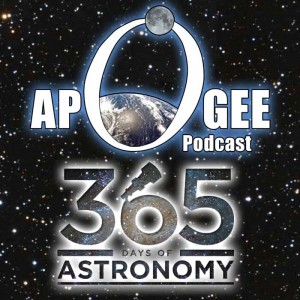Podcaster: Cosmic
Title: The Apogee Podcast – Telling Tails about Globular Clusters
Links: astroandmusic.blogspot.com
Youtube: https://www.youtube.com/user/cosmiclettuce
Twitter: @AstroAndMusic
Email: cosmiclettuce@gmail.com
Description: In this Apogee Podcast, Cosmic discusses the study of stars being ejected from globular clusters, and how these tidal tails are formed by internal and external forces.
Papertrail:
Bonaca et al — https://arxiv.org/pdf/1910.00592.pdf
Combes et al — https://arxiv.org/pdf/astro-ph/9910148.pdf
Michie — http://articles.adsabs.harvard.edu/pdf/1963MNRAS.125..127M
Woolley & Robertson —http://articles.adsabs.harvard.edu/pdf/1956MNRAS.116..288W
Background Music: ‘Dreams Electric’ by Geographer
Bio: Cosmic (aka Matt Cheselka) is an independent research astronomer and space musician.
Today’s sponsor: Big thanks to our Patreon supporters this month: Dustin A Ruoff, Frank Tippin, Brett Duane, Jako Danar, Joseph J. Biernat, Nik Whitehead, Timo Sievänen, Steven Jansen, Casey Carlile, Phyllis Simon Foster, Tanya Davis, Rani B, Lance Vinsel, Steven Emert, Barbara Geier
Please consider sponsoring a day or two. Just click on the “Donate” button on the lower left side of this webpage, or contact us at signup@365daysofastronomy.org.
Or please visit our Patreon page: https://www.patreon.com/365DaysOfAstronomy
Transcript:
Hello! This is Cosmic, and welcome to the Apogee podcast! In these podcasts, I chronicle a single astronomical reference thread from the past to the present. Many threads are possible — I’ve chosen just one. These podcasts will take place at or near the date of the apogee which is when, along its orbit around the Earth, the Moon is furthest away.
The apogee for this podcast happens tomorrow, 10 Octover 2019, at 18:30 UTC. The lunar distance at that time will be 405,901 km, which is 476 km closer than last apogee on 13 September, and 842 km further away than the next apogee on 7 November.
If you have any topic suggestions for future podcasts, I would be happy to take a look at them. I can be reached at cosmiclettuce AT gmail DOT com.
The characteristics of how stars move through and out of globular clusters can tell us quite a bit about the internal structure of these clusters, and about the environment surrounding them. Many stars are ejected, forming tidal tails. Identifying these stars and measuring their characteristics is the topic of a recent paper by Bonaca et al, who point out that understanding these tidal tails can give us
information about the detailed structure of the galaxy and allow us to probe dark matter subhaloes.
This work goes back at least several decades. In a paper written in 1956 by Richard Van Der Riet Woolley and Denise A. Robertson in the Monthly Notices of the Royal Astronomical Society, the dynamics and distribution of stars on the outskirts of globular clusters was modeled. In their model, they determined that stars within a certain radius were “relaxed” — meaning that they were more-or-less in a low dynamic energy state moving very little toward or away from the center of the cluster. Stars outside of this radius, however, were found to be almost certainly ejected from the cluster on a timescale less than their ages.
The distribution of stars and their motions in the outer regions of globular clusters was picked up in a paper written in 1963 by Richard W Michie. In this paper, also published in the MNRAS, Michie expands upon previous work in modeling spherical stellar systems by eliminating many approximations made in previous models. Specifically, the positional distribution of stars, the distribution of velocities, their orbital motions, and distribution of mass. Michie notes that the most important effect not taken into account is the fact that these systems aren’t isolated.
The model developed by Michie was picked up in 1999 in a paper by Combes et al published in the journal Astronomy and Astrophysics. Based on these previous models, Combes et al state that only a small fraction of the globular clusters that initially formed with the Milky Way galaxy exist today, and that 75% of those will be destroyed in the next Hubble time (currently estimated to be about 14.4 billion years). The primary contributor to the destruction of these systems is when they cross the plane of the galaxy, but Combes et al point out
that other factors like giant molecular clouds, spiral arms, and bars play a secondary role. In their paper, Combes et al report on observations of tidal tails “in order to better quantify the effect of external pertubations”. In addition, they were interested in the fate of escaped stars in order to better understand their orbits while they were part of the cluster.
These tidal tails continue to be studied by researchers like Bonaca et al, who are interested in what these tails can tell us about the evolution of the galaxy, it’s structure (spiral arms and bars), and the presense and characteristics of any dark matter subhaloes. They do this by looking closely at the globular cluster Palomar 5 located in the constellation of Serpens. The tidal tail of this cluster extends over 25 degrees in the sky and has been found to have a very complex structure. This structure implies an interesting and dynamic evolution of both this cluster and the Milky Way galaxy.
Thanks for listening! Until the next apogee, I bid you Peace.
End of podcast:
365 Days of Astronomy
=====================
The 365 Days of Astronomy Podcast is produced by Planetary Science Institute. Audio post-production by Richard Drumm. Bandwidth donated by libsyn.com and wizzard media. You may reproduce and distribute this audio for non-commercial purposes. Please consider supporting the podcast with a few dollars (or Euros!). Visit us on the web at 365DaysOfAstronomy.org or email us at info@365DaysOfAstronomy.org. This year we will celebrates the Year of Everyday Astronomers as we embrace Amateur Astronomer contributions and the importance of citizen science. Join us and share your story. Until tomorrow! Goodbye!


